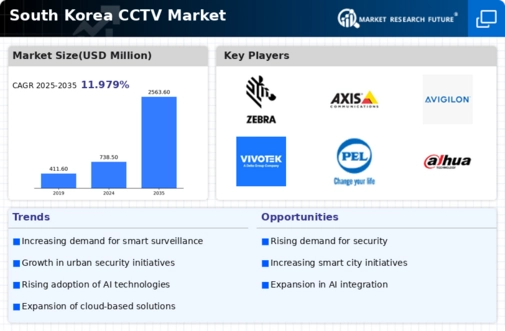The competitive dynamics within the CCTV market exhibit a landscape characterized by rapid technological advancements and a growing emphasis on security solutions. Key growth drivers include the increasing demand for surveillance systems across various sectors, such as retail, transportation, and public safety. Major players like Hikvision (CN), Dahua Technology (CN), and Hanwha Techwin (KR) are strategically positioned to leverage innovation and regional expansion. Hikvision (CN) focuses on enhancing its AI capabilities, while Dahua Technology (CN) emphasizes partnerships to broaden its market reach. Hanwha Techwin (KR) is investing in digital transformation initiatives, collectively shaping a competitive environment that prioritizes technological superiority and customer-centric solutions.
In terms of business tactics, companies are increasingly localizing manufacturing to reduce costs and optimize supply chains. The market structure appears moderately fragmented, with several key players exerting substantial influence. This fragmentation allows for a diverse range of offerings, yet the collective strength of these companies drives competitive pressures that compel continuous innovation and operational efficiency.
In October 2025, Hikvision (CN) announced the launch of its latest AI-driven surveillance platform, which integrates advanced analytics and cloud capabilities. This strategic move is significant as it positions the company to meet the rising demand for intelligent security solutions, enhancing its competitive edge in a market that increasingly values data-driven insights.
In September 2025, Dahua Technology (CN) entered a strategic partnership with a leading telecommunications provider to enhance its IoT capabilities. This collaboration is pivotal, as it enables Dahua to integrate its surveillance systems with smart city initiatives, thereby expanding its footprint in urban security solutions and aligning with global trends towards smart infrastructure.
In August 2025, Hanwha Techwin (KR) unveiled a new line of eco-friendly cameras designed to reduce energy consumption by 30%. This initiative not only reflects a commitment to sustainability but also addresses the growing consumer preference for environmentally responsible products, potentially enhancing brand loyalty and market share.
As of November 2025, current trends in the CCTV market are heavily influenced by digitalization, sustainability, and the integration of AI technologies. Strategic alliances are increasingly shaping the competitive landscape, fostering innovation and collaborative solutions. Looking ahead, competitive differentiation is likely to evolve from traditional price-based competition towards a focus on technological innovation, reliability in supply chains, and the ability to deliver comprehensive security solutions that meet the diverse needs of consumers.




















Leave a Comment